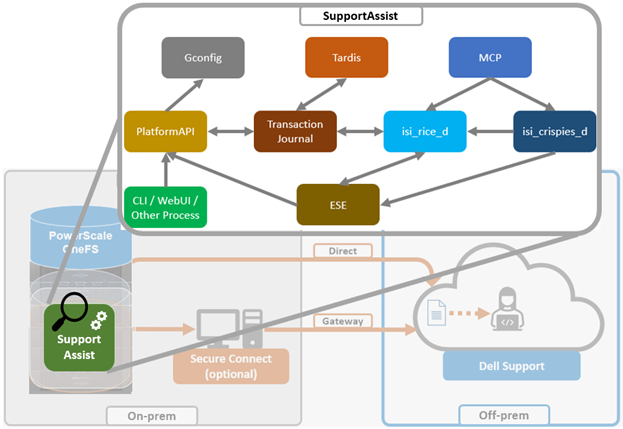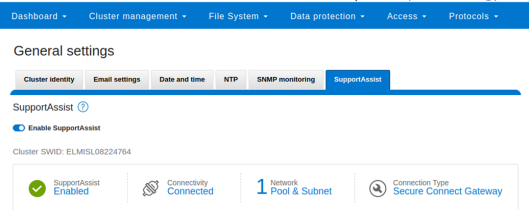The previous article in this series looked at an overview of OneFS SupportAssist. Now, we’ll turn our attention to its core architecture and operation.
Under the hood, SupportAssist relies on the following infrastructure and services:
| Service | Name |
| ESE | Embedded Service Enabler. |
| isi_rice_d | Remote Information Connectivity Engine (RICE). |
| isi_crispies_d | Coordinator for RICE Incidental Service Peripherals including ESE Start. |
| Gconfig | OneFS centralized configuration infrastructure. |
| MCP | Master Control Program – starts, monitors, and restarts OneFS services. |
| Tardis | Configuration service and database. |
| Transaction journal | Task manager for RICE. |
Of these, ESE, isi_crispies_d, isi_rice_d, and the Transaction Journal are new in OneFS 9.5 and exclusive to SupportAssist. In contrast, Gconfig, MCP, and Tardis are all legacy services that are used by multiple other OneFS components.
The Remote Information Connectivity Engine (RICE) represents the new SupportAssist ecosystem for OneFS to connect to the Dell backend, and the high level architecture is as follows:

Dell’s Embedded Service Enabler (ESE) is at the core of the connectivity platform and acts as a unified communications broker between the PowerScale cluster and Dell Support. ESE runs as a OneFS service and, on startup, looks for an on-premises gateway server. If none is found, it connects back to the connectivity pipe (SRS). The collector service then interacts with ESE to send telemetry, obtain upgrade packages, transmit alerts and events, etc.
Depending on the available resources, ESE provides a base functionality with additional optional capabilities to enhance serviceability. ESE is multithreaded, and each payload type is handled by specific threads. For example, events are handled by event threads, binary and structured payloads are handled by web threads, etc. Within OneFS, ESE gets installed to /usr/local/ese and runs as ‘ese’ user and group.
The responsibilities of isi_rice_d include listening for network changes, getting eligible nodes elected for communication, monitoring notifications from CRISPIES, and engaging Task Manager when ESE is ready to go.
The Task Manager is a core component of the RICE engine. Its responsibility is to watch the incoming tasks that are placed into the journal and assign workers to step through the tasks state machine until completion. It controls the resource utilization (python threads) and distributes tasks that are waiting on a priority basis.
The ‘isi_crispies_d’ service exists to ensure that ESE is only running on the RICE active node, and nowhere else. It acts, in effect, like a specialized MCP just for ESE and RICE-associated services, such as IPA. This entails starting ESE on the RICE active node, re-starting it if it crashes on the RICE active node, and stopping it and restarting it on the appropriate node if the RICE active instance moves to another node. We are using ‘isi_crispies_d’ for this, and not MCP, because MCP does not support a service running on only one node at a time.
The core responsibilities of ‘isi_crispies_d’ include:
- Starting and stopping ESE on the RICE active node
- Monitoring ESE and restarting, if necessary. ‘isi_crispies_d’ restarts ESE on the node if it crashes. It will retry a couple of times and then notify RICE if it’s unable to start ESE.
- Listening for gconfig changes and updating ESE. Stopping ESE if unable to make a change and notifying RICE.
- Monitoring other related services.
The state of ESE, and of other RICE service peripherals, is stored in the OneFS tardis configuration database so that it can be checked by RICE. Similarly, ‘isi_crispies_d’ monitors the OneFS Tardis configuration database to see which node is designated as the RICE ‘active’ node.
The ‘isi_telemetry_d’ daemon is started by MCP and runs when SupportAssist is enabled. It does not have to be running on the same node as the active RICE and ESE instance. Only one instance of ‘isi_telemetry_d’ will be active at any time, and the other nodes will be waiting for the lock.
The current status and setup of SupportAssist on a PowerScale cluster can be queried via the ‘isi supportassist settings view’ CLI command. For example:
# isi supportassist settings view Service enabled: Yes Connection State: enabled OneFS Software ID: ELMISL08224764 Network Pools: subnet0:pool0 Connection mode: direct Gateway host: - Gateway port: - Backup Gateway host: - Backup Gateway port: - Enable Remote Support: Yes Automatic Case Creation: Yes Download enabled: Yes
This can also be obtained from the WebUI by navigating to Cluster management > General settings > SupportAssist:

SupportAssist can be enabled and disabled via the ‘isi services’ CLI command set. For example:
# isi services isi_supportassist disable The service 'isi_supportassist' has been disabled. # isi services isi_supportassist enable The service 'isi_supportassist' has been enabled. # isi services -a | grep supportassist isi_supportassist SupportAssist Monitor Enabled
The core services can be checked as follows:
# ps -auxw | grep -e 'rice' -e 'crispies' | grep -v grep root 8348 9.4 0.0 109844 60984 - Ss 22:14 0:00.06 /usr/libexec/isilon/isi_crispies_d /usr/bin/isi_crispies_d root 8183 8.8 0.0 108060 64396 - Ss 22:14 0:01.58 /usr/libexec/isilon/isi_rice_d /usr/bin/isi_rice_d
Note that once a cluster is provisioned with SupportAssist, ESRS can no longer be used. However, customers that have not previously connected their clusters to Dell Support may still provision ESRS, but will be presented with a message encouraging them to adopt the best practice of using SupportAssist
Additionally, SupportAssist in OneFS 9.5 does not currently support IPv6 networking, so clusters deployed in IPv6 environments should continue to use ESRS until SupportAssist IPv6 integration is introduced in a future OneFS release.